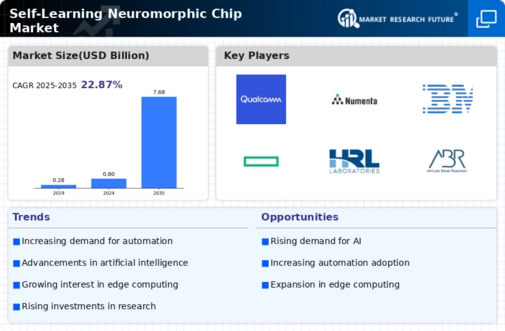Top Industry Leaders in the Self Learning Neuromorphic Chip Market

The Competitive Landscape of the Self-Learning Neuromorphic Chip Market
The human brain, the ultimate learning machine, has long inspired technological progress. Today, it finds an echo in the nascent self-learning neuromorphic chip market. These chips, mimicking the neural architecture of the brain, promise revolutionary advancements in artificial intelligence, robotics, and edge computing. Navigating this dynamic space requires a clear understanding of the competitive landscape, the strategies of key players, and the factors shaping its future trajectory.
Key Player:
- Qualcomm
- Numenta
- Samsung Group
- IBM
- Hewlett Packard
- Brainchip Holdings Ltd.
- HRL Laboratories
- Applied Brain Research Inc.
- General Vision
- Intel Corporation
Strategies Adopted by Leaders:
- Technology Prowess: Intel's Loihi and Cerebras Systems' CS1 lead the charge with high-density arrays of artificial neurons and powerful interconnect architectures, setting the benchmark for processing power and scalability.
- Vertical Specialization: Brainchip focuses on edge AI applications with low-power neuromorphic chips for drones and robots, while Mythic AI caters to high-performance computing with scalable rack-mounted neuromorphic systems.
- Partnership Play: IBM collaborates with universities and research institutions to accelerate neuromorphic research and development, fostering co-creation and shaping the future of the market.
- Open-Source Platforms: The Open Neuromorphic Platform (ONP) promotes open-source hardware and software tools, lowering entry barriers and empowering new players in the ecosystem.
- Focus on Energy Efficiency: Cerebras Core prioritizes sustainable AI with liquid cooling and efficient chip design, addressing concerns about the high energy consumption of current neuromorphic systems.
Factors for Market Share Analysis:
- Performance and Scalability: Companies offering superior processing power, efficient memory access, and scalable architectures command premium prices and secure market share by enabling faster, more complex, and adaptable AI applications.
- Application Specificity: Tailoring neuromorphic chips to specific applications, like image recognition in autonomous vehicles or natural language processing, is crucial for market penetration and user adoption.
- Development Tools and Software Support: Robust software development kits, training algorithms, and simulation tools are essential for enabling efficient development and deployment of neuromorphic AI solutions.
- Power Consumption and Sustainability: Addressing the high energy footprint of current neuromorphic chips through innovative design and cooling technologies is critical for wider adoption and environmental responsibility.
- Cost Competitiveness and Availability: Balancing advanced features with attractive pricing and ensuring accessibility, particularly for academic and research institutions, is crucial for market growth.
New and Emerging Companies:
- Startups like Groq and InBrain: These innovators focus on niche segments like spiking neural networks and biomimetic chip architectures, pushing the boundaries of neuromorphic hardware and mimicking brain functionality.
- Academia and Research Labs: MIT's Neurotechnology Lab and Stanford University's Human-AI Interaction Lab explore brain-computer interfaces, neuromorphic computing algorithms, and ethical considerations in AI development, shaping the future of the market.
- Established AI and Chipmakers: Companies like Google AI and Nvidia leverage their expertise in AI and semiconductor technologies to enter the neuromorphic chip market, potentially driving down costs and accelerating adoption.
Industry Developments:
Qualcomm:
- November 2023, Demonstrated a neuromorphic computing architecture with improved scalability and power efficiency, targeting edge AI applications.
- July 2023, Partnered with a university to develop new learning algorithms for spiking neural networks on neuromorphic hardware.
Numenta:
- October 2023, Released an open-source neuromorphic hardware platform for researchers and developers to build and experiment with SNNs.
- August 2023, Announced a collaboration with a large cloud provider to offer cloud-based access to its neuromorphic computing platform.
Samsung Group:
- September 2023, Unveiled a prototype neuromorphic chip with high-density neuron and synapse integration, aiming for advanced AI processing.
- December 2023, Invested in a startup developing neuromorphic chips for autonomous vehicle applications.
